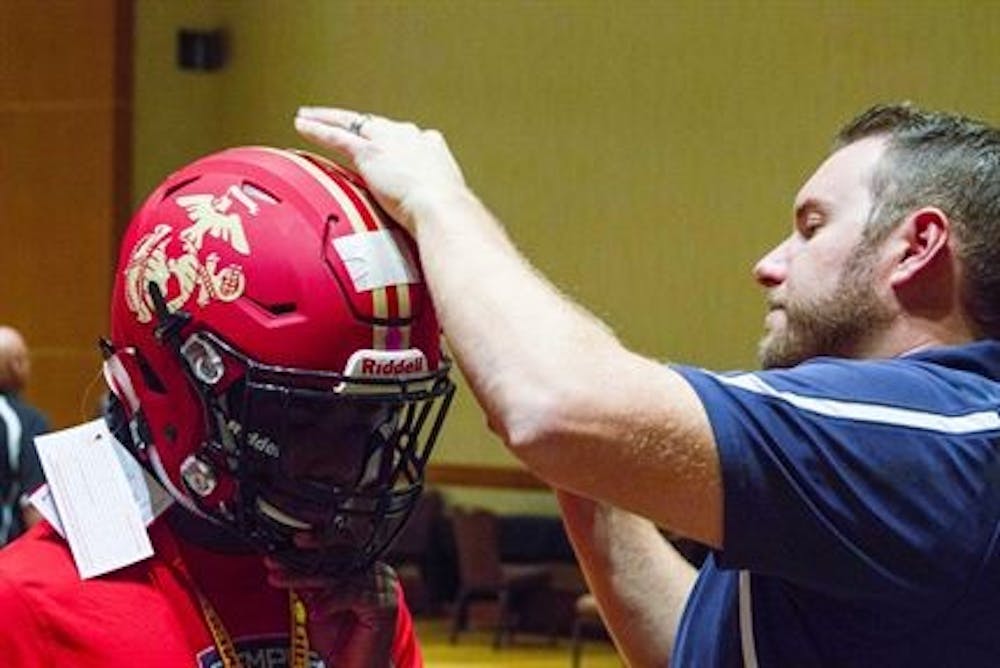For American football fans, the end of the Super Bowl may elicit uncontrollable joy or despondent regret. But for Hopkins neurosurgeon Dr. Nicholas Theodore, the Super Bowl’s conclusion brought an immense sense of satisfaction.
Since 2018, Theodore has served as the chairman of the National Football League’s (NFL) innovative Head, Neck and Spine committee. Under his tenure, not a single player has suffered a traumatic brain injury while playing in the Super Bowl.
“That’s great, especially from the perspective of the Super Bowl,” Theodore remarked, expanding on the difficulty of achieving such a feat.
In an interview with The News-Letter, he explained that the NFL is technically the parent organization for the league’s 30 franchises. Combined with the NFL Players’ Association, he says, “there are a lot of moving parts.”
As Committee Chairman, Theodore serves as part physician, part politician and part negotiator, trying to balance the league’s commercial interests and the players’ safety.
Overall, the Committee is a group of neurosurgeons, neurologists, psychologists, engineers and full-time statisticians. They serve as an advisory group to the NFL, recommending rule changes, equipment improvements and sideline neurological consultants.
Despite difficulties, the committee has had its share of success. Theodore explained that the elimination of head tackles is one of the most effective directives issued by the committee.
“The main rule we’ve managed to implement is the rule outlawing tackles with the head, because we’ve seen that if you flex your neck at the point of impact, concussion risk significantly goes up,” Theodore noted. “Since then we’ve seen a huge drop in concussions, almost 20 percent since 2017.”
Theodore has always been interested in neurotrauma. During his time as a neurosurgeon in the Marine Corps and the Navy, he researched brain and spinal cord injuries.
Concussions and other aspects of sports trauma became his forte when he became director of the Barrow Neurological Institute in Arizona, where Theodore also served as the team neurosurgeon for the Arizona Cardinals.
He joined Hopkins Medicine in 2017, the same year that the NFL recorded its highest-ever number of concussions. Asked to serve on the Head, Neck and Spine Committee that year, he rose to the position of Chairman the following year.
As Chairman, Theodore has also witnessed rapid advancements in helmet technology. The Committee has traditionally sorted helmets into “green,” “yellow,” and “red” categories.
According to Theodore, “green” helmets are the highest-performing, and players who use those helmets suffer significantly less concussions; “yellow” helmets are usable, but an upgrade is advised; while use of “red” helmets is strongly discouraged.
Improved helmet technology is especially significant during the preseason, a time where concussions are still significantly higher than during the regular season.
“The majority of preseason concussions occur in linemen,’’ Theodore explained, pointing out that linemen may crash into one another as part of their jobs on the offense and defense.
Another major source of preseason concussions is the players who are on the edge of making the team, and thus have an incentive to exert more effort to the detriment of proper form.
Improved helmet technology reduces the force of concussive impacts on the skull for both sets of players, thus reducing traumatic brain injuries.
Finally, Theodore cites the introduction of sideline neurological consultants as another major factor in the decline of football-related traumatic brain injuries.
There are at least three independent neurological consultants at every game watching all tackles from multiple angles; the consultants can notify team doctors about potential concussions from their various vantage points.
Data collection like this has been an especially useful tool in helping the committee achieve its goal of reducing head injury.
“We have all this data about concussion frequency. We know with different types of hits and player velocities, concussions are more or less likely. While the game of football will never be 100-percent safe, we can reduce the likelihood of a concussed individual suffering a second concussion in quick succession,” Theodore said. “Two concussions in a very short period of time can cause very significant brain swelling, and we’ve made it a top priority to reduce the likelihood of that occurring in the future.”
As chairman, one of Theodore’s biggest concerns is improving future player safety. Mentioning the current state of mouth guard force sensors (force sensors located in the mouth guard that all football players wear to reduce the risk of tongue laceration), he contemplated the future of research on player safety.
“I think we’ll be able to analyze eye movement, saliva and blood for signs of concussions, and pull players out that show those signs,” he said. “Outside of astronauts, NFL players are probably some of the best studied humans in the world.”
His biggest hope for the next 10 years? Employing machine-learning to create personalized concussion predictions.
“Soon we’ll be able to develop personalized algorithms, predicting concussion risk based on the category of hit and a variety of other factors like age, previous concussion history, momentum at impact,” he said. “The field has come far, but there is a long way to go as well.”
Until then, though, we can expect Theodore to continue his tireless efforts and to extend the streak of concussion-less Super Bowls.





